
The Australian Ex-Prisoners of War Memorial was dedicated on Friday, 6 February 2004. It is located on the southern approaches to the Ballarat Botanical Gardens, on Wendouree Parade and adjacent to Lake Wendouree.

The Australian Ex-Prisoners of War Memorial was dedicated on Friday, 6 February 2004. It is located on the southern approaches to the Ballarat Botanical Gardens, on Wendouree Parade and adjacent to Lake Wendouree.
Now recognised nationally as the official National Prisoner of War Memorial, [1] the memorial honours more than 35,000 Australians who were held prisoner during the Boer War, World War I, World War II and the Korean War. It is a place of national honour, remembrance and healing for all Australians. The memorial takes visitors on a journey to a different time and place, where heroism, sacrifice and mateship were the defining characteristics of the prisoners of war.
Between the 1950s and 1990s surviving prisoners of war from the Ballarat region met regularly and various plans for the establishment of a focal point for commemoration were periodically discussed. Throughout that time the Australian Federal Government had given periodic undertakings that a permanent monument would be eventually built in Canberra (the national capital). By the early 1980s, the Ballarat City Council granted a parcel of land adjacent to the city gardens to allow local veterans a place to establish a permanent focal point for the Ballarat POWs. By the mid-1990s the Australian Federal Government still had no plan for a permanent monument to be established in Canberra, thus the surviving POWs in Ballarat were prompted into action and began planning the building of a permanent memorial in their city to be largely privately funded and established with minimum government assistance.
With significant support from the Ballarat branch of the Returned and Services League (RSL) of Australia, a local sculptor, Peter Blizzard, was commissioned to design a concept for the memorial. The vision provided by the sculptor was for a monument far greater in scale and scope than that originally envisaged by the veterans. However, support for a significantly larger monument that would commemorate all Australian POWs was immediate. Funding was provided through lotteries, private donations, benevolent organisations (most notably Tattersall's), the City of Ballarat, local businesses, and finally the Federal and Victorian State Governments. Work commenced on the construction of the memorial in early 2003 with much of the labour and materials donated or provided at cost.
The Ballarat RSL, assisted by volunteers, worked for over 10 years to compile names to form the first national database of Australian prisoners of war. Prior to 2004, the Australian Federal Government and the Australian Defence Force held no complete central list, database, or consolidated record of its prisoners of war. Information was recorded only on individual personnel records held in Defence archives at the Central Army Records Office (CARO) in Melbourne. It is believed that there may be some names still missing, and the memorial has a postscript section allocated to enable further additions.
Approximately 130 metres (430 ft) long, the memorial features a long pathway of light-grey basalt pavers cut to resemble railway sleepers, reminiscent of those used on the Thai–Burma Railway. [2] To the southern side are two canted black polished granite walls with the names of all known Australian prisoners of war. They are listed alphabetically by war and no rank is acknowledged. The two walls are separated in the middle by a square pool of water that features six large basalt obelisks. These feature the names of the countries where Australian POWs were held. The obelisks centralised in the pool of water symbolise the Australian POWs being cut off and isolated from their homeland by the ocean. [2] The sixth obelisk is deliberately toppled on its side and broken, symbolising "The Fallen". [3]
To the northern flank of the memorial is a larger basalt obelisk that serves as the focal point and cenotaph of the memorial which is flanked by the flags of the Royal Australian Navy, the Royal Australian Air Force, the Australian Merchant Navy and the Australian National Flag, representing the Australian Army. At the western end of the memorial another stone wall is situated with cascading water and the words "LEST WE FORGET"; this marks the completion of the journey. The memorial is surrounded by plantings of native and jungle grasses as well as conifer and deciduous trees.[ citation needed ]

Ballarat is a city in the Central Highlands of Victoria, Australia. Ballarat has a population of 115,951 as of 2022 making it the third-largest inland city in Australia and the third-largest city in Victoria.

The Macquarie Place Park, also known as the Macquarie Place Precinct, is a heritage-listed small triangular urban park located in the Sydney central business district in the City of Sydney local government area of New South Wales, Australia. The former town square and milestone and now memorial, public park and monument is situated on the corner of Bridge Street and Loftus Street. It is named in honour of Governor Lachlan Macquarie. The precinct includes The Obelisk or Macquarie Obelisk, the Sirius anchor and gun/cannon, the Statue of Thomas Sutcliffe Mort, the historic Underground Public Conveniences and the Christie Wright Memorial Fountain. The property was added to the New South Wales State Heritage Register on 5 March 2010.

The Anzac Memorial is a heritage-listed war memorial, museum and monument located in Hyde Park South near Liverpool Street in the CBD of Sydney, Australia. The Art Deco monument was designed by C. Bruce Dellit, with the exterior adorned with monumental figural reliefs and sculptures by Rayner Hoff, and built from 1932 to 1934 by Kell & Rigby. This state-owned property was added to the New South Wales State Heritage Register on 23 April 2010.

The Rats of Tobruk Memorial is on Anzac Parade, the principal ceremonial and memorial avenue of Canberra, Australia.

Kings Domain is an area of parklands in Melbourne, Victoria, Australia. It surrounds Government House Reserve, the home of the governors of Victoria, the Sidney Myer Music Bowl, and the Shrine Reserve incorporating the Shrine of Remembrance.
Lakeside Mental Hospital, originally known as Ballarat Asylum, later as Ballarat Hospital for the Insane and finally, before its closure, as Lakeside Psychiatric Hospital, was an Australian psychiatric hospital located in the suburb of Wendouree, the north-western fringe of Ballarat, Victoria, Australia.
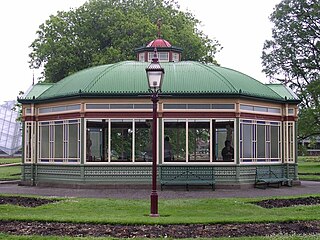
The Ballarat Botanical Gardens Reserve, located on the western shore of picturesque Lake Wendouree, in Ballarat, Victoria, Australia, covers an area of 40 hectares which is divided into three distinct zones. The central Botanical Gardens reserve in the 'gardenesque' style of the Victorian pleasure garden. On either side there are open parkland buffers known as the North and South Gardens. The Gardens celebrated its sesquicentenary in 2007. Renowned fly fishing author Alfred Ronalds provided some of the first trees and plants for the gardens from his nursery on the other side of the lake.

The Capas National Shrine in Barangay Aranguren, Capas, Tarlac, Philippines was built by the Philippine government as a memorial to Allied soldiers who died at Camp O'Donnell at the end of the Bataan Death March during the Second World War.
Wendouree is a large suburb on the north western rural-urban fringe of the city of Ballarat, in Victoria, Australia. It is the second most populated suburb in the City of Ballarat with a total of 10,376 inhabitants at the 2021 census.

The Sturt Street Gardens is a central reservation running along Sturt Street, one of the main thoroughfares of Ballarat,. The formal gardens span 13 city blocks from Grenville Street in the east to Pleasant Street in the west, are 20 metres (22 yd) wide and cover an area of 2.87 hectares running east–west.
The Prime Ministers Avenue is a collection of busts of the first twenty-nine prime ministers of Australia. They are lined along an avenue of horse chestnuts at the Ballarat Botanical Gardens, bronze casts mounted on polished granite pedestals.

Trams in Ballarat were first used for public transport in 1887. They ceased to operate as a means of public transport in 1971, but a section continues to be operated today as a tourist attraction.
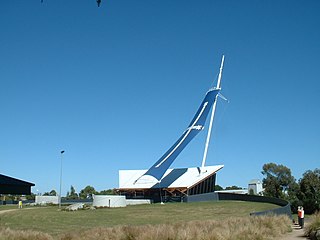
Eureka is a small eastern suburb of Ballarat, Victoria, Australia. It was originally part of Ballarat East but became its own suburb in 1946 in recognition of the area's significance to Australian history. Eureka is bordered by Specimen Creek to the north, Canadian Creek to the south, Queen and Joseph streets to the west and Kline and Stawell Street to the east. The suburb takes its name from the Eureka Lead – a lead is an ancient river bed that contains gold – of the Eureka Mining Company and is most notable as the site of the historic event of the Eureka Rebellion. This was the site where the rebel miners flew the Eureka Flag for the first time; a flag that has since become a symbol of the working class and trade union movement and, at times, Australian republicanism.

The Ballarat Showgrounds is a multi-purpose venue in Wendouree, a suburb of Ballarat, Victoria, Australia, owned by the City of Ballarat and since 1934, the home of the Ballarat Show and agricultural show.
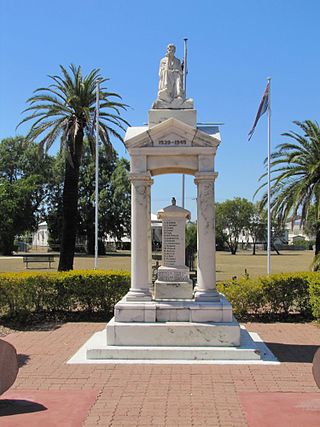
Weeping Mother Memorial is a heritage-listed memorial at Hickey Street, Gatton, Queensland, Australia. It was designed by F. Williams & Co and built in 1922 by the same company. The memorial was added to the Queensland Heritage Register on 21 October 1992.

The Sandakan Memorial Park is a memorial site built in the former grounds of the former Sandakan camp in the Malaysian state of Sabah. The site is dedicated as a memory for all prisoners in the camp who died during the Sandakan Death Marches, and to those died during a march to Ranau. It is also recognises the suffering and sacrifice of the native population. This park hosts the Sandakan Memorial Day service on August 15.
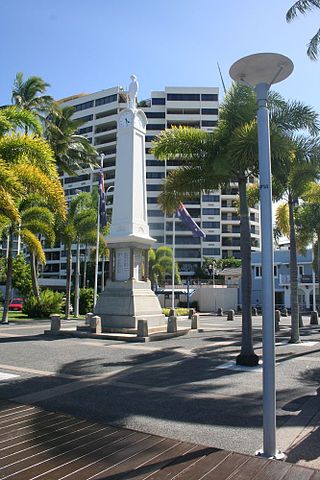
Cairns War Memorial is a heritage-listed memorial at The Esplanade, Cairns City, Cairns, Cairns Region, Queensland, Australia. It was built in 1925. It was added to the Queensland Heritage Register on 21 October 1992.
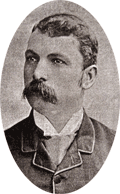
Frederick William Commons (1860-1925) was an Australian monumental sculptor who was commissioned to carve the monuments in the Ballarat Town Hall. He was commissioned to carve four allegorical figures for Parliament House, Melbourne, each 12 ft high and for £2,100. However, it never eventuated due to the depression. Today, many of his works can be seen in statues and monuments in the Ballarat district.

Military Memorials of National Significance meet a set of ten criteria laid down in the Military Memorials of National Significance Act of 2008 which received assent in the Australian Government on 12 Jul 2008. All such memorials are on public land within a State or the Northern Territory but outside the Australian Capital Territory. The Act allowed memorials outside Canberra to be recognised as National Memorials and the first to receive such recognition was the Australian Ex-Prisoners of War Memorial at Ballarat. The Member for Ballarat, Catherine King was instrumental in passing this legislation.